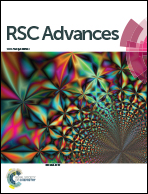Surfactant-assisted preparation of surface-enhanced Raman scattering-active substrates
Abstract
As shown in the literature, cationic surfactant hexadecyltrimethylammonium bromide (CTAB) has been predominantly employed in the shape-controlled synthesis of Au nanoparticles (NPs) in solution to produce the corresponding shape-dependent Au NP catalysts. Among the different techniques used to obtain rough metal substrates with surface-enhanced Raman scattering (SERS) activities, controllable and reproducible surface roughness can be generated using an electrochemical process. In this work, innovative SERS-active substrates with Au NPs are prepared for the first time using sonoelectrochemical deposition-dissolution cycles (SEDDCs) in CTAB-containing electrolytes. Encouragingly, the SERS intensity for both the model probe molecule Rhodamine 6G (R6G) and the general example molecule 4-mercaptopyridine (4-MPy) adsorbed onto the developed substrates are higher by more than one order of magnitude compared with R6G and 4-MPy adsorbed onto SERS-active substrates prepared in solutions in the absence of CTAB. Moreover, the limits of detection (LOD) recorded for the developed SERS-active substrates are as low as 2 × 10−15 and 1 × 10−10 M for R6G and 4-MPy, respectively.


 Please wait while we load your content...
Please wait while we load your content...